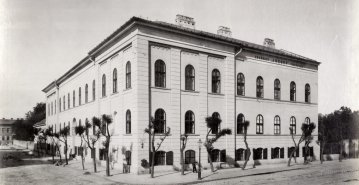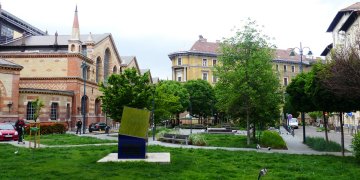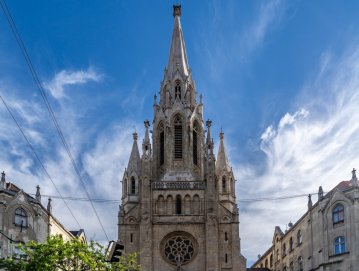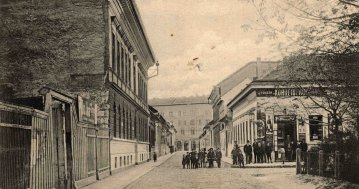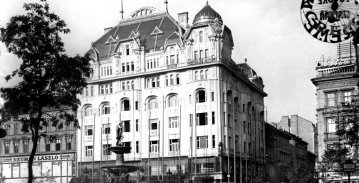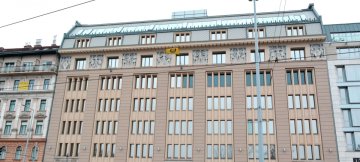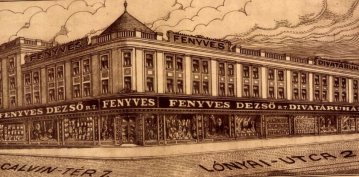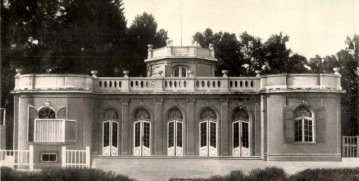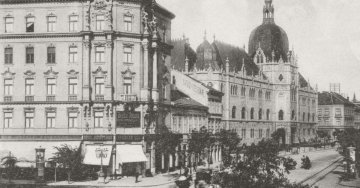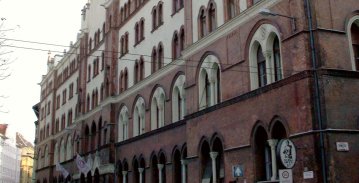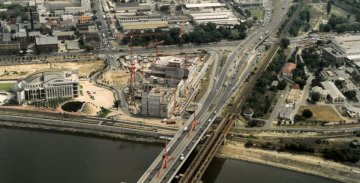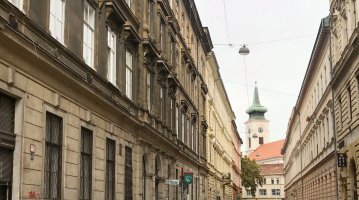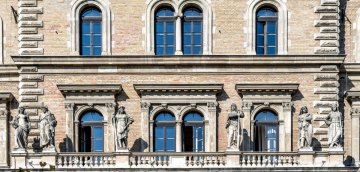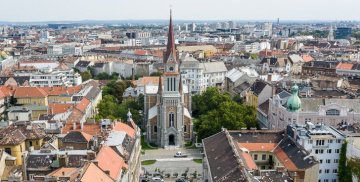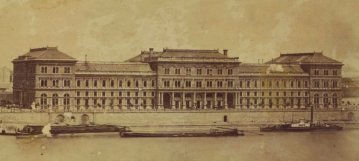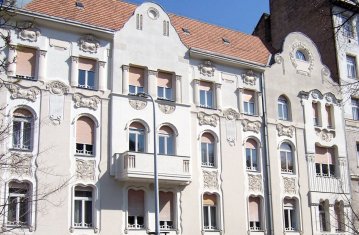
Gönczi Ambrus
Cikkek
Once upon a time there was a boy's orphanage - Josephinum designed by Mihály Pollack got its name from Palatine Joseph¬
October 10, 2021 at 10:00 AM
The support and upbringing of young children who lost their parents, and the satisfaction of their daily needs in Hungary until the middle of the 18th century was undertaken by the churches. The first city orphanage opened in Kőszeg in 1741, and then in the following decades similar institutions maintained and operated by the settlements were built in Selmecbánya [today Banská Štiavnica], Sopron, Nagyszombat [today Trnava] and Veszprém. In Pest, although prominent citizens donated significant sums for this purpose in the 1790s, only 100 years after the opening of the one in Kőszeg was the foundation stone of the first educational institution of this type laid, and it named after Palatine Joseph.
Vendors once sold their goods on Csarnok Square in Ferencváros, where shoppers and tourists now relax
May 26, 2021 at 9:00 AM
Although Csarnok (Market Hall) Square in Ferencváros did not exist before 1896, after the opening of the Central Market Hall, a busy life began on the 9th District's smallest, but all the more special square, where hundreds of graves were unearthed during a 2016 hotel construction, highlighting a small detail of the area's vibrant past.
Neo-Gothic wonder on Üllői Road – Church in Ferencváros designed by Sándor Aigner
May 10, 2021 at 9:00 AM
A large number of architects played a huge role in making Budapest a metropolis. They created numerous beautiful plans between the 1870s and 1910s. Many of our public buildings and dwellings that still stand are the fruits of their work. While this view is generally accepted, the names of several masters have almost been forgotten. Such is the case of Sándor Aigner, who designed many churches as a master of Gothic Revival architecture. His most important work is the Perpetual Adoration Church in Ferencváros.
No place to call home – József Attila's family moved every six months
April 19, 2021 at 10:00 AM
Ferencváros, including Ferenc Square, was where one of the greatest figures of Hungarian poetry, Attila József, lived from his birth until the age of 14. His father, Áron József, abandoned the family in 1908, when the youngest child, Attila, was three years old. Despite having moved a lot before, his mother, Borbála Pőcze, was forced to find a new home almost every six months due to being behind on their rent.
A forgotten side of Kálvin Square – Lost buildings: The Geist and Pintér Buildings
March 2, 2021 at 9:00 AM
Kálvin Square is a transport hub, one of the busiest and most popular squares in Budapest. Museums, restaurants and hotels fill the nearby streets, but the square itself is also of interest. At the junction of Kecskeméti Street and Kálvin tér, where the huge blocks of the Korona Hotel now stand connected by a bridge, there were once two beautiful residential buildings houses. A look at their history is worthwhile.
Art Deco on Boráros Square – Former headquarters of the Hangya Cooperatives turns 100
February 6, 2021 at 11:00 AM
In 1920 a new chapter began in the life of the Hangya Cooperative, which once had shops all over the country. The company decided to celebrate the upcoming 25th anniversary of its creation by building a new headquarters. The art deco-style building designed by Dénes Györgyi was completed quickly at present-day 30 Közraktár Street. The proud palace has stood for one hundred years on the three plots, highlighting the former success of the Hangya Cooperative.
Shop assistants with subscriptions to hairdressers – The Kálvin Square department store
January 8, 2021 at 3:00 PM
The department store is one of Kálvin Square's defining buildings and stands on a plot that once housed a school operated by the Reformed Church. In the interwar years, the city knew the shop as the Fenyvess Department Store. And while it only bore the name for 25 years, many remember the name to this day.
Pioneering reinforced concrete – Aladár Münnich born 130 years ago
December 18, 2020 at 2:00 PM
One of the most versatile architects of the interwar years in Hungary Aladrás Münnich designed villas, residential buildings, bank buildings, are large-scale urban planning projects. He was also a popular expert writer. But he is best known for his massive industrial project, both at home and abroad.
The birth of Lottóház – Historic buildings lost to the 1956 revolution
December 10, 2020 at 2:00 PM
A small plaza can be found at the junction of Ferenc Boulevard and Üllői Road. It was named in 1996. It is known as Angyal István Park. There is no inscription to indicate this despite a statue of a paper aeroplane being erected in 2014, and most passers-by do not know that the city honoured one of the heroes of the 1956 revolution, the leader of the Tűzoltó Street insurgents, with the square 24 years ago. And perhaps even fewer know that before 1956 the square did not even exist, but was covered by three residential buildings standing side by side.
From pawn shop to University – Construction of the Central Pawnbroker Offices began 120 years ago
November 30, 2020 at 10:00 AM
A huge building on Lónyay Street has stood empty for fifteen years. It has been unused for so long that most passers-by will not even remember its name. Yet for more than a hundred years, it was the centre of trading in pledged goods. Over the past years, there have been plans to build a hotel in the walls, films have been shot within them, and there were fears that it would be demolished. In the end, this beautiful example of turn-of-the-century architecture is being saved.
Built on a freight station: the Millennium City Centre
November 17, 2020 at 9:00 AM
Budapest is a city of constant change. This is especially true for parts of the city that were once industrial centres or served these industries. The decaying remains of 100–150-year-old factories are often called rust belts. While the future of many of these areas remains uncertain, some examples have been completely transformed and given an entirely new lease on life. Over the past 25 years, the Millennium City Centre has sprouted where the Danube-Bank Freight Station once stood and has become such an area.
A forgotten house – The origins of Eötvös József College
November 4, 2020 at 9:00 AM
A small street near Kálvin Square bears the name of Pál Gönczy, a writer on educational subjects and teacher at the Reformed Secondary School of Pest. In 1895 a small teacher training institute named after Gönczi's former ministerial superior, Count József Eötvös was opened here. At the time it was known as Csillag Street. Loránd Eötvös founded the College, and its first headteacher was Géza Bartoniek. They are the protagonists of the first 15 years of institution's history, but the small building where early students worked with their professors until 1911, was forgotten.
Stunning decorations line the Renaissance-revival palace of the Main Customs House
October 19, 2020 at 9:00 AM
The Main Customs House building, which today houses Corvinus University is a major sight in Budapest. The façade is decorated by 22 statues of figures from Greek-Roman mythology and traditional Hungarian crafts. The main courtyards, staircases, the internal and external decorations all highlight just how great a masterpiece the building is. Construction of the building began 150 years ago in 1870, according to plans drawn up by one of the greatest Hungarian architects, Miklós Ybl.
A place of beauty in the heart of the city – 225 years of Bakáts Square
October 10, 2020 at 12:00 PM
There are few places in modern Budapest where the defining institutions of community life can be found side by side. There may not even be such a place any more. Nevertheless, one-hundred or one-hundred and fifty years ago people believed it was vital that they not have to cover large distances to go to church, drop their Children of at school, reach a hospital quickly or sort official matters out. It was best, if church, school, hospital, administrative offices or maybe even a cinema or social club could be found nearby. Bakáts Square was just such a place.
Replanned twice by the great Ybl – Construction of the Main Customs House began 150 years ago
September 30, 2020 at 10:00 AM
The stunning Renaissance revival palace of the Main Customs House by Miklós Ybl is better known today as Corvinus University. The building has defined the view of the Danube embankment since its completion. A lesser-known fact about the building is that it was initially planned for Kossuth Square. Foundation work began but later stopped when Gyula Andrássy (the prime minister in office at the time) supported the Budapest City Council in the dispute about the site. The building was moved to Ferencváros, and Ybl was forced to redraw his plans for the palace twice before construction began 150 years ago.
New Drug Research Centre to open next year in former hospital building
August 24, 2020 at 9:00 AM
The capital has few hospital buildings opened more than a hundred years ago that do not need to be thoroughly renovated, remodelled or modernised. There was also a period, not so long ago, when such institutions were closed rather than maintained. But the list of empty unused buildings also goes on and on, as they await new use of demolition. Fortunately, there are already examples of healthcare buildings being renovated without major changes in function. An example is the former Schöpf-Merei Ágoston Hospital.

